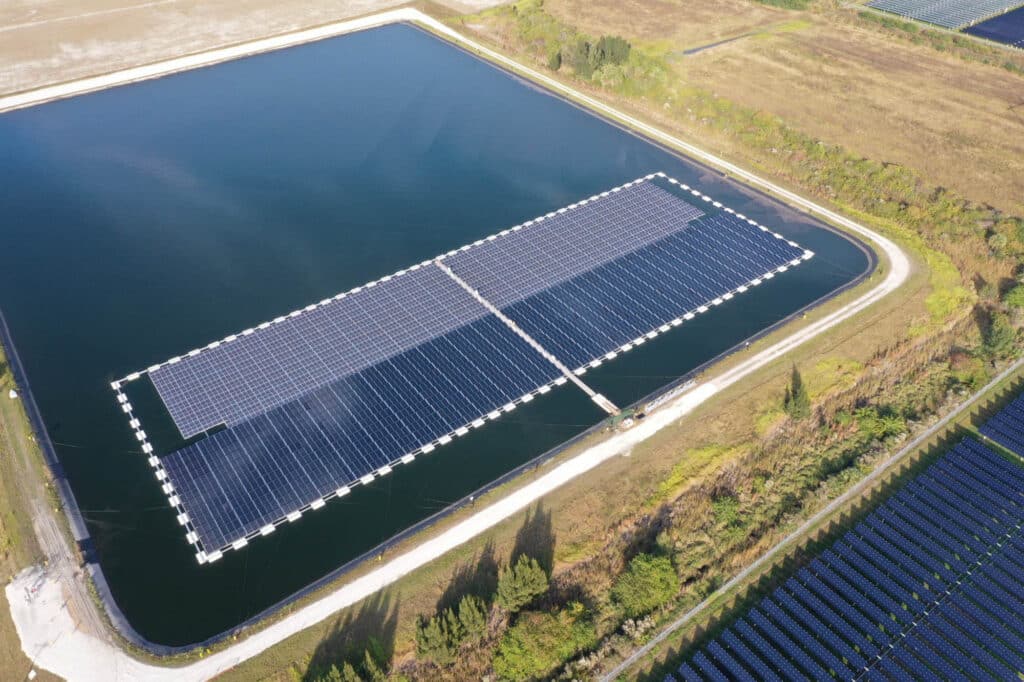Floating solar arrays may be the next step in expanding U.S. clean energy and powering modern cities, factories, and homes. Whether you’re looking for a clean energy alternative or finding a way to leverage bodies of water to power your projects, explore the basics of floating solar platforms.
See how AccuSolar floating photovoltaics, or FPV, can take your energy operations to the next level.
Floating Solar: The Basics
Floating solar panels have been in use for years in other parts of the world. Governments and corporations in Asia and Europe have equipped floating platforms with PV panels to expand energy opportunities without using valuable land. According to the Floating Solar Market Report produced by World Bank Group, ESMAP, and SERIS in 2019, a conservative estimate of the global FPV potential is 400 GWp.
What Is Floating Solar?
Floating solar combines modern solar panel designs with durable, buoyant floating platforms. Unlike land-based panels, floating photovoltaics don’t compete for industrial, agricultural, or residential land use. This type of platform can easily come alongside existing land-based panels, hydropower plants, or other energy sources for efficient energy yield.
Floating panels aren’t as affected by the terrain type and strong winds. Land panels must be positioned at an angle and often rotate on an axis to continue to absorb energy throughout the day. Flat installation on a floating surface can avoid issues with strong winds damaging panels, rotating mechanisms breaking, and hilly terrain blocking sunlight.
How To Use Floating Solar
The general layout of floating solar panels, or photovoltaics, is similar to that of a land-based system. The layout includes the following components:
- PV modules
- Floats or pontoons
- Mooring lines
- Anchoring points
- Combiner box
- Central inverter
- Transformer
- Transmission system
To use a floating solar array requires proper solar irradiance and a favorable climate. The depth and surface characteristics of the water also need to be taken into account. Bathymetry reports may be required to select a suitable location for efficient, long-lasting power production.
AccuSolar Floating Solar Energy Platforms
There are a significant number of FPV producers capable of creating a system for your municipal or corporate power needs. Identify areas where you can use floating solar and explore these benefits of AccuSolar platforms to see what sets us apart.
- Custom Designs
Our framed panel design is based on AccuDock technology. These dependable, custom-built structures support your exact number of panels for a personalized floating solar platform.
All AccuSolar arrays are designed with walkways to streamline installation and maintenance processes. These walkways allow maintenance professionals to inspect panels without standing on and potentially damaging them. - Innovative Engineering
Our floating solar arrays use patented, proprietary technology for a durable surface to install the latest solar panels. These floating sections are made in the U.S. – with all U.S. parts.
These dynamic structures use closed-cell expanded polystyrene foam to create a surface that won’t list or tilt, even under load. The foam is complemented by marine-grade aluminum components. - Streamlined Installation
While the installation process varies depending on the location and situation, here are the basic stages of development for a floating PV project:
– Site identification
– Study of pre-feasibility
– Study of feasibility
– Financing
– Design
– Construction
– Commission
Installing an AccuSolar floating solar platform can take up to six months for the full project to be complete, but it will ultimately depend on the site and specifications. Once you’ve identified the site, financed the project, and reached out to the AccuSolar team to create a custom support structure, you’ll schedule the delivery of the down-position assembly. - Reduced Maintenance
A floating solar platform requires routine maintenance. Most, however, are subject to fewer risks and maintenance issues than land-based alternatives. For example, a floating structure is subjected to less dust and soiling than land-based PV panels.
Maintenance plans for solar modules, floats, and mounting structures include monthly, quarterly, and yearly inspections. These ensure that the floats remain buoyant and the components aren’t significantly affected by algae, corrosion, or physical damage.
For the anchoring and mooring systems, the maintenance plan includes half-yearly and biennial inspections. These inspections help spot signs of damage to the cables, chains, shackles, and other components keeping the floating solar arrays in place.
Environmental Impact of Floating Solar Arrays
Solar energy in the United States can power municipalities, factories, conservations, and residential homes. Floating renewable energy is an important step in the journey of U.S. clean energy initiatives. Solar data could supply up to 80% of U.S. electricity requirements, with floating solar being a significant addition to land-based systems.
Proven floating technology can help reduce the reliance on fossil fuels to reduce our carbon footprint. Together with hydroelectric, wind, geothermal, and other renewables, solar energy is an important investment in the future of electricity production.
AccuSolar Floating Solar Platforms
Explore floating solar innovation today. Contact AccuSolar to learn more about the installation process, benefits of these floating arrays, and steps to create clean energy for your corporate energy use.





